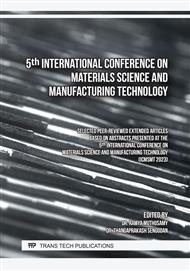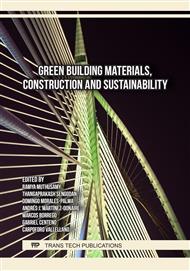[1]
W. M. U. Thomas, E. D. Nicholas, A. Hall, and C. Cb, "Friction stir Welding for the transportation industries," Materials & Design, vol. 18, 1998, p.269–273.
DOI: 10.1016/s0261-3069(97)00062-9
Google Scholar
[2]
P. Rao, J. Akram, and M. Misra, "Low temperature frictions stir welding of P91 steel," Defence Technology, vol. 17, 2015, pp.115-118.
Google Scholar
[3]
J. Fathi, P. Ebrahimzadeh, R. Ferasati, and R. Teimouri, "Friction stir welding of aluminum 6061-T6 in presence of watercooling: Analyzing mechanical properties and residual stress distribution," Int. J. Light. Mater. Manuf., 2019, pp.251-255.
DOI: 10.1016/j.ijlmm.2019.04.007
Google Scholar
[4]
S. A. Khodir and T. Shibayanagi, "Friction stir welding of dissimilar AA2024 and AA7075 aluminum alloys," Materials Science and Engineering B, vol. 148, 2008, p.82–87.
DOI: 10.1016/j.mseb.2007.09.024
Google Scholar
[5]
K. Sekar and P. Vasanthakumar, "Microstructural evaluation of similar and dissimilar welding of aluminum metal matrix hybrid composite by friction stir welding," Mater. Sci. Forum, vol. 979 MSF, p.124–128, 2020.
DOI: 10.4028/www.scientific.net/msf.979.124
Google Scholar
[6]
Sekar. K, Vasanthakumar. P Friction Stir Welding of Al-Cu Alloy Metal Matrix Composites Reinforced with B4C and Graphite Particle Fabricated by Stir Casting and Thixoforming Method, M. S. Shunmugam and M. Kanthababu, "Advances in Additive Manufacturing and Joining," in Editors Proceedings of AIMTDR, 2018.
DOI: 10.1007/978-981-32-9433-2_44
Google Scholar
[7]
V. Pandian and S. Kannan. "Effect of high entropy particle on aerospace-grade aluminium composite developed through combined mechanical supersonic vibration and squeeze infiltration technique". J. Manuf. Process, vol. 74, p.383–399, 2022.
DOI: 10.1016/j.jmapro.2021.12.024
Google Scholar
[8]
V. Pandian and S. Kannan. "Processing and preparation of aerospace-grade aluminium hybrid metal matrix composite in a modified stir casting furnace integrated with mechanical supersonic vibration squeeze infiltration method". Mater. Today Commun., vol. 26, p.101732, 2021.
DOI: 10.1016/j.mtcomm.2020.101732
Google Scholar
[9]
K. Sekar and P. Vasanthakumar, "Microstructural and Mechanical Properties of Dissimilar Aluminium Alloys by Friction Stir Welding". Key Engineering Materials, vol. 934 KEM, pp.129-138, 2022.
DOI: 10.4028/p-9oujj7
Google Scholar
[10]
K. Sekar and P. Vasanthakumar, "Mechanical and tribological properties of Al6063 hybrid composites reinforced with SiC/ZrO2 by stir casting and thixoforming process," Mater. Sci. Forum, vol. 979 MSF, p.47–51, 2020.
DOI: 10.4028/www.scientific.net/msf.979.47
Google Scholar
[11]
G. Orhan, G. Hapçi, and Ö. Keleş, "Application of response surface methodology (RSM) to evaluate the influence of deposition parameters on the electrolytic Cu-Zn alloy powder," Int. J. Electrochem. Sci., vol. 6, no. 9, 2011, p.3966–3981.
DOI: 10.1016/s1452-3981(23)18303-9
Google Scholar
[12]
B. Rajeswari and K. S. Amirthagadeswaran, "Experimental investigation of machinability characteristics and multi-response optimization of end milling in aluminium composites using RSM based grey relational analysis," Measurement, vol. 105,2017, p.78–86.
DOI: 10.1016/j.measurement.2017.04.014
Google Scholar
[13]
K. Sekar, "Mechanical and tribological properties of Al7475-SiCp composites by stir casting method and wear rate modeling using RSM," Sādhanā, vol. 44, no. 5, 2019, p.129.
DOI: 10.1007/s12046-019-1105-1
Google Scholar
[14]
K. Sekar and P. Vasanthakumar, "Mechanical properties of Al-Cu alloy metal matrix composite reinforced with B4C, Graphite and Wear Rate Modeling by Taguchi Method," Mater. Today Proc., vol. 18, p.3150–3159, 2019.
DOI: 10.1016/j.matpr.2019.07.190
Google Scholar
[15]
V. Pandian and S. Kannan, "Numerical prediction and experimental investigation of aerospace-grade dissimilar aluminium alloy by friction stir welding," J. Manuf. Process., vol. 54, no. February, p.99–108, 2020.
DOI: 10.1016/j.jmapro.2020.03.001
Google Scholar
[16]
P.Vasanthakumar, K. Sekar, and J. Jayantherababu, "Thermal prediction and experimental validation of Friction Stir Welded Aerospace Grade Aluminium Alloy," J. Phys. Conf. Ser., vol. 1240, no. 1, 2019.
DOI: 10.1088/1742-6596/1240/1/012150
Google Scholar
[17]
S. R. Nathan, V. Balasubramanian, S. Malarvizhi, and A. G. Rao, "Effect of welding processes on mechanical and microstructural characteristics of high strength low alloy naval grade steel joints," Def. Technol., vol. 11, no. 3,2015, p.308–317.
DOI: 10.1016/j.dt.2015.06.001
Google Scholar
[18]
S. Chand et al., "Effect of FSW welding speed on microstructure and microhardness of Al-0.84Mg-0.69Si-0.76Fe alloy at moderate rotational tool velocity," IOP Conf. Ser. Mater. Sci. Eng., vol. 330, no. 1,2018, p.0–12.
DOI: 10.1088/1757-899x/330/1/012022
Google Scholar
[19]
J. C. Hou, H.J. Liu, and Y.Q. Zhao, "Influences of rotation speed on microstructures and mechanical properties of 6061-T6 aluminum alloy joints fabricated by self-reacting friction stir welding tool," Int. J. Adv. Manuf. Technol., vol. 73, no. 5–8,2014, p.1073–1079.
DOI: 10.1007/s00170-014-5857-9
Google Scholar
[20]
N.Z. Khan, Z.A. Khan, and A. N. Siddiquee, "Effect of Shoulder Diameter to Pin Diameter (D/d) Ratio on Tensile Strength of Friction Stir Welded 6063 Aluminium Alloy," Mater. Today Proc., vol. 2, no. 4–5,2015, p.1450–1457.
DOI: 10.1016/j.matpr.2015.07.068
Google Scholar
[21]
M. Almeida, R. Erthal, E. Padua, L. Silveira, and L. Am, "Talanta Response surface methodology ( RSM ) as a tool for optimization in analytical chemistry," vol. 76,2008, p.965–977.
DOI: 10.1016/j.talanta.2008.05.019
Google Scholar
[22]
M. Grujicic, J. S. Snipes, S. Ramaswami, R. Galgalikar, and C. Yen, "Computational analysis of the intermetallic formation during the dissimilar metal aluminum-to-steel friction stir welding process," vol. 10, 2017, p.1–21.
DOI: 10.1177/1464420716673670
Google Scholar



